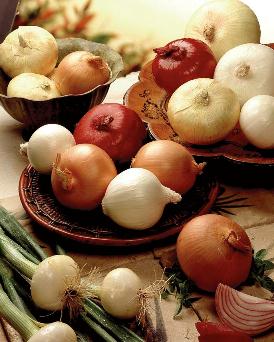Lesson Plan: Onions—Flavor from the Ground Up
01 June 2011By Kim Reddin, courtesy of the National Onion Association
 Onions provide color and texture to a dish, but their flavor is what really makes them irresistible and virtually irreplaceable in the kitchen. From raw to caramelized, the flavor of an onion has many layers.
Onions provide color and texture to a dish, but their flavor is what really makes them irresistible and virtually irreplaceable in the kitchen. From raw to caramelized, the flavor of an onion has many layers.
Onion Production
Commercially grown in 20 states from coast to coast, onions are the third-largest fresh-vegetable industry in the United States; Idaho-Eastern Oregon, Washington and California are the leading production areas. The National Onion Association estimates that fewer than 1,000 U.S. farmers plant more than 142,000 acres of onions each year. Americans consume nearly 20 pounds of onions per capita annually.
Flavor Factors
Onion flavor is determined by many factors including genetics, planting location, soil and temperature. While compounds such as sugars and organic acids can contribute to what people taste, a special class of biologically active organosulfur compounds is what actually give onions their distinctive flavor and aroma.
“Flavor,” according to Dr. Irwin Goldman, respected onion researcher and professor of horticulture at University of Wisconsin-Madison, “is determined by thiosulfinates and other sulfur-based compounds which are influenced by flavor precursors [compounds that accumulate in onion bulbs].” Genetics and location play a significant role in taste. Onions grow in response to temperature at planting and sunlight or day length. A short-day or long-day genetic variety determines where and what season the onion is planted. Once in the ground, genetics then determine how the onion takes up nutrients. “The genetic background allows an onion to accumulate a large or small amount of flavor precursors, soluble solids and water,” said Goldman.
“Soil can be important because the more sulfur it contains, the more flavor precursors and potential flavor might be present,” Goldman said. Water can dilute the sulfur-based compounds while stress can increase them, he said. “Sulfur compounds are mainly used by the plant to defend itself,” said Goldman.
“Temperature can likely affect flavor as well,” said Goldman, “but soil type, sulfur content, water availability, stress and genetics are the key elements for flavor.”
Pungency is commonly assessed by measuring pyruvate, which is produced in a mole for mole relationship with the flavor precursors. It is, however, only an indicator of pungency as pyruvate does not directly contribute to onion flavor.
Onion Types
A domestic supply of onions is available year-round. Fresh onions, available from March to August, have thin, light-colored skins. Because they have a higher water content, they typically taste sweeter and milder than storage onions. This higher water content also makes them more susceptible to bruising. With their delicate taste, fresh onions are an ideal choice for salads and other fresh and lightly cooked dishes.
The term “sweet onion” is used to describe the mildest fresh onions. Many seed varieties of specialty onions are being developed and grown for their mild, sweet flavor. Sweet-onion varieties grown in the United States are available from March to September. To achieve a year-round sweet-onion supply, producers will import onions primarily from South America and Mexico between October and February.
Storage onions, available August to April, have multiple layers of thick, dark-colored, papery skin. Being low in water content, storage onions have higher amounts of solids. Best known for their intense flavor and pungency, storage onions are perfect for caramelizing, sautéing, stewing or roasting.
Fresh vs. Storage Onion Preparation
In general, onions with a higher water content (fresh onions) take slightly more time to cook. Onions with a higher percentage of solids (storage onions) will cook in less time.
In one study, fresh onions took about 40 minutes to caramelize while storage onions took just 20 minutes.
In addition, the higher water content of fresh onions will require a longer resting time after breading rings or blooms. This will allow the breading to adhere better.
For more information about onions, visit www.onions-usa.org.
Kim Reddin is the industry and public-relations director for the National Onion Association based in Greeley, Colo.
Download attachments:
- Download the Lesson Plan (282 Downloads)
